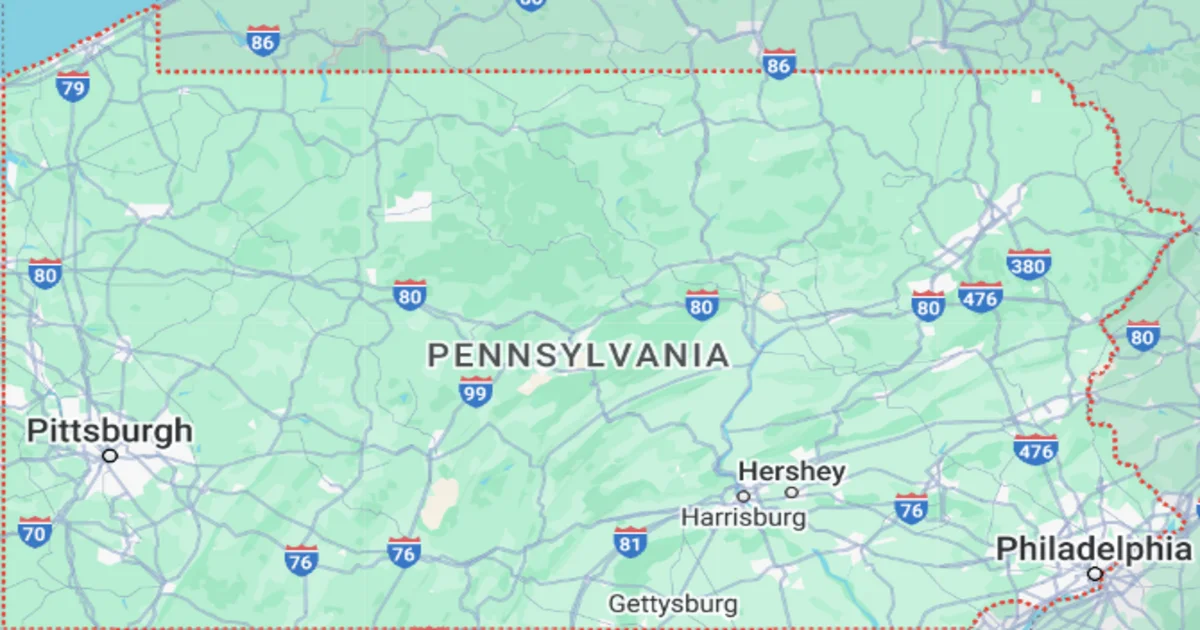Image Credit-Google
On Friday morning, the National Weather Service (NWS) issued an urgent red flag warning for areas of Pennsylvania, highlighting the increased risk of wildfire spread due to extreme fire weather conditions. This alert is active from 8 a.m. to 6 p.m. and covers six counties: Carbon, Monroe, Berks, Lehigh, Northampton, and Bucks. According to the NWS, weather conditions in these areas are set to create ideal circumstances for fire to start and spread rapidly. Expected weather conditions include sustained winds from the west at 10 to 20 mph, gusting up to 30 mph, and humidity as low as 26%.
The NWS cautions that any fire ignited in these conditions is likely to spread quickly, creating a serious hazard. Residents in affected areas are urged to avoid outdoor burning and take precautionary measures to reduce the risk of accidental fire ignition.
What is a Red Flag Warning?
A red flag warning, issued by the National Weather Service, signals an elevated risk of wildfire, either due to ongoing extreme fire weather conditions or those forecasted to develop shortly. High temperatures, low humidity, and strong winds are typical contributors, setting the stage for rapid fire spread if an ignition occurs. These warnings are issued based on a combination of factors, including vegetation dryness, temperature, humidity, and wind speeds.
How You Can Stay Safe During a Red Flag Warning
During a red flag warning, taking proactive steps is crucial to minimize wildfire risks and keep yourself and your community safe. Here are some recommended actions from the National Weather Service to help prevent accidental fires during this critical period:
1. Secure Burn Barrels
Burn barrels, commonly used in rural areas for waste disposal, can pose a significant risk during high fire danger days. If burning is allowed, ensure that burn barrels are equipped with a weighted metal cover with holes no larger than 3/4 of an inch. This precaution reduces the risk of stray embers escaping and igniting dry vegetation nearby. Always monitor the burn barrel closely and never leave it unattended, even for a short period.
2. Handle Smoking Materials with Care
Improperly discarded cigarette butts and matches are common causes of wildfires, especially during red flag conditions. Never discard lit cigarette butts on the ground or throw them from moving vehicles, as they can easily ignite dry grass and other flammable materials. Always fully extinguish cigarette butts in an ashtray or a non-flammable container before disposing of them.
3. Practice Prudent Fire Extinguishing
Whether it’s a barbecue or a campfire, all outdoor fires should be fully extinguished after use to prevent accidental wildfire spread. When putting out a fire, douse it generously with water and stir until no residual heat remains. If using charcoal, ensure it is completely cool before disposal. Leaving live or hot charcoal unattended is especially dangerous, as residual heat can ignite dry materials nearby, leading to an unintentional wildfire.
4. Avoid Leaving Fires Unattended
Any outdoor fire should be monitored continuously until it is fully extinguished. Even a small campfire, if left unattended, can produce drifting embers or sparks that may ignite nearby dry foliage. To prevent this, always keep a close watch on fires, making sure they are completely out before leaving the area.
Why These Precautions Matter
Understanding the seriousness of a red flag warning and following these precautions can significantly reduce the risk of wildfire ignition. As the saying goes, “An ounce of prevention is worth a pound of cure.” Wildfires can have devastating consequences, including loss of life, destruction of property, and long-lasting damage to natural ecosystems. By staying informed, acting responsibly, and prioritizing safety, you can help prevent wildfires and protect both lives and property during these hazardous conditions.
FAQ: Red Flag Warning
1. What exactly does a red flag warning mean?
- A red flag warning means that weather conditions are ripe for extreme fire activity, typically due to a combination of high temperatures, low humidity, and strong winds. These factors create an environment in which fires can ignite and spread rapidly.
2. How often are red flag warnings issued?
- Red flag warnings are issued whenever weather conditions meet specific thresholds that elevate wildfire risks. They can occur at any time but are more common during hot, dry seasons.
3. Can I use a grill during a red flag warning?
- It’s best to avoid using grills or any outdoor cooking appliances with open flames during a red flag warning. If you must, keep it far from dry grass, trees, or other flammable materials, and have a fire extinguisher or water source nearby.
4. Is it safe to burn leaves or yard waste during a red flag warning?
- No, it’s not safe. Burning leaves or any yard waste during a red flag warning significantly increases the risk of an unintentional wildfire.
5. What should I do if I spot a small fire?
- If you notice a small fire, alert local fire authorities immediately by calling 911. Do not attempt to put it out yourself if it is spreading quickly or if it appears too large to control.
6. How can I stay updated on fire weather warnings?
- Local weather apps, the National Weather Service website, and local news stations provide regular updates on fire weather warnings. You can also enable notifications on weather apps to receive real-time alerts.
Conclusion
In times of red flag warnings, each action to prevent fires matters immensely. As this fire weather alert remains active across Pennsylvania, staying vigilant, informed, and prepared can make all the difference. Following safety precautions like securing burn barrels, handling smoking materials responsibly, and extinguishing all fires thoroughly will help protect communities and natural landscapes from devastating wildfires.
